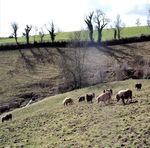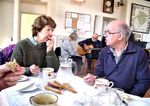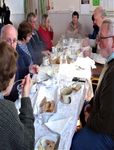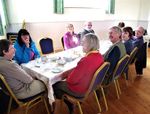BERE FERRERS and HALLOWELL WOOD 2018 - Tamar Valley AONB
←
→
Page content transcription
If your browser does not render page correctly, please read the page content below
BERE FERRERS and HALLOWELL WOOD 2018
Sunshine was streaming through my windows when I rose this morning and later as most of us sped
towards Bere Ferrers they must have been thinking the same as me, what a beautiful day it was for a
walk. We barely noticed when we got going that a few
clouds had gathered as all eyes were on the unusually
high tide on our right, we couldn’t help but compare it
with former walks at this Devonshire village when
there were mud flats as far as the eye could see.
Today’s leader set off like a rabbit out of a trap so in
no time those at the front had reached a stony bridle-
path while the remainder had become quite spread
out behind, but as soon as she realised, Juliette waited
for everyone to catch up before continuing at a slower
pace. Matching hedges bordered the path ahead
clothed mainly in evergreen ferns and topped with deciduous trees plus a few early
Daffodils. Although we have spotted one or two of their yellow blooms since
January, we would see many more today including this one with six pale coloured
petals and a darker yellow trumpet, the month of March is when Daffodils are
most prolific here in the Tamar Valley, bringing pleasure to all who witness this
annual spectacle as it unfolds week by week. Though their botanic name is
narcissus, this particular variety, Narcissus pseudonarcissus is also known as the
Lent Lily as they bloom around the time that Lent is celebrated in Britain.
The word Lent, comes from the Anglo-Saxon word meaning ‘to lengthen’ as Lent comes at a time in
the year when the hours of daylight are lengthening as spring approaches, however the name Lent
was later chosen by Christians who spend time preparing to celebrate the resurrection of Jesus
around this time of year. Nowadays Lent gives believers time to reflect on their lives whilst fasting
from food and festivities, many use the time to volunteer at a charity or donate money to a good
cause as we would be doing later at the church hall.
Eventually the footpath continued across a couple of fields before all twenty-one of us emerged into
a lane and paused before continuing on to Hole Farm. We discovered that the path then cut right
through their
yard with its
cluster of oldstone buildings and on across their land but as we
attempted to open a gate to gain access, a thickly
coated Shetland Pony barred our way. While one of
us held the gate open a crack, the rest of us managed
to squeeze through without letting the pony escape.
However, he was not alone but was just the most
inquisitive of a multi-coloured herd spread out across
the field behind him. These adorable animals that had
until then been quietly nibbling the young grass, looked up as we entered their territory and then
rushed across to greet us, but while some of our group made a fuss of them, others were more wary.
It came as a pleasant surprise as we walked onwards whilst still accompanied by ponies, that this
field was nowhere near as wet and muddy as it had been last year and we made it across without
incident to reach the wooden stile on the far side.
We had now entered Hallowell Woods, the part of
the walk I had been most looking forward to as I
love walking in ancient woodland. During our
break near the stile some of us discussed the ivies
that marched up the trunks of the deciduous trees
and even in some case, right into their canopies
making the trees look more like evergreens.
Further on, we were pleased to see that a number
of young saplings had been planted replacing the
stumps of former trees. I tried to identify the
various tree skeletons as I walked but without
much success but I had better luck recognising the
sounds of a couple of birds. A robin was singing its
heart out nearby and further on when hearing the
'tchack' sound coming from above I knew that this was the call of the Jackdaw, but no matter how
hard I looked, I was unable to spot the actual bird that was making the sound. Jackdaws are the
smallest members of the crow family and the sound they make is the origin of their name, so as I
walked along looking up that is what I expected to see. Of
course had I been carrying my binoculars, I knew another
way to identify them is by their light grey nape and pale
white iris, which stand out against the black plumage.
I didn’t know until I looked into the subject that juveniles lack
the grey nape of the adults and are born with blue-grey eyes
which change to brown in the first winter and white once
they gain their adult plumage. Like their cousins the Crows
and Ravens, Jackdaws are just as much at home in farmland
and woodland, as they are in urban landscapes. Their diet is
largely composed of seeds, fruit and invertebrates, but as
Jackdaws are also carrion eaters, they will pick at road kill or
even take other birds’ eggs.The path was good through here with a familiar earthy smell as we strolled along disturbing the ground accompanied by that of rotting wood. As we walked I noticed a few fallen trees while other specimens leaned at awkward angles supported by their neighbours that were still firmly rooted to the ground. Were the high winds that accompanied last week’s Storm Emma to blame I wondered, or had they lain like that for many years? Whatever the answer, the Woodland Trust that maintains this and many other local woods had already made a start with tackling the damage. Once everyone had emerged from the woodland it was time for a bit of road walking back to the village, the time had now reached mid-day. We were just a stones throw away when the heavens opened, a short sharp shower of icy hail stones coming at us from an angle and bouncing off the road all around. Rainwear was hastily donned and our pace quickened as we headed for the village hall. Safely inside everyone removed their wet clothing and footwear in a back room before entering the hall itself where a number of tables were laid out for today’s charity lunch in aid of Lent. Parishoners were on hand to wait not just on us, but on some of the villagers too, just as they are on every Wednesday throughout the month of March; two musicians even played as we ate. On the menu today was a choice of four different soups…Pumpkin, Spicy Red Pepper, Pea and Ham and Artichoke along with bread, butter and cheese and a choice of tea or coffee all for a donation of just £3 which was shared between two charities, one was local and the other worldwide; this year’s chosen charities were……… The Shekinah Mission Based in Devon near the Plymouth Pavilions, the Shekinah Mission was founded in December 1992, and operates principally in the deprived Stonehouse area of the City. They provide help and support to the homeless and rough sleepers, those with drug or alcohol addiction, ex-offenders, those with physical or mental health needs, the long-term unemployed, and the elderly and or disabled. Their drop in centre provides showers, clothing and food and has a visiting GP and chiropodist.
Christian Aid Christian Aid is the official relief and development agency and works with people of all faiths and none. The charity was set up in Britain in 1945, initially to help refugees following the Second World War. In the 21st century, Christian Aid's work is still founded on Christian faith and inspired by hope, justice and equality but now it works across the wider world. The charity’s aims now involve stopping poverty, supporting civil society and providing disaster relief in the refugee camps by sending out parcels. More recently Christian Aid managed to reach more than 500,000 people with food, shelter and healthcare after the Asian Tsunami.
You can also read



























































